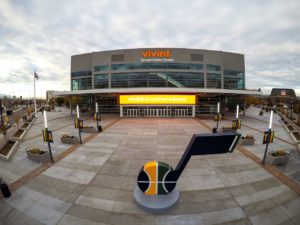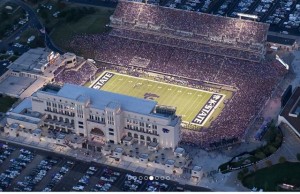“I was at the [Winter] Olympics where KT [Korea Telecom] and Intel set up the first 5G network,” said Saw in a recent phone interview. “Stadiums will be a good showplace for the capabilities of 5G. It’s pretty impressive what you can do with 5G that you can’t do today.”
Saw, who was CTO at WiMAX play Clearwire before that company became part of Sprint, will be the first to admit that the network built for the PyeongChang Olympics wasn’t “true” 5G, but said it was a good precursor. He also added that it wasn’t a cost-conscious deployment, something MSR had heard from other sources who said Intel and KT didn’t hold back when it came to spending.
“They spent a lot of money [on the network],” Saw said.
But some of the services the Olympic network was able to support included local viewing of replays using Intel’s True View technology, which gives fans the ability to watch a play or action from a 360-degree angle. While Intel has had limited deployments of the technology at some U.S. sporting events, for the Olympics Saw said they used hundreds of cameras linked over millimeter wave frequencies, which can offer very low latency.
“They needed [to have the images] in real time,” Saw said, and built the millimeter wave network to do just that. While the network “wasn’t fully compliant to the subsequent 5G standards, a lot of what they built is the forerunner to 5G,” Saw said. “It was a pretty cool showcase, and will certainly find a home in stadiums.”
No Millimeter Wave spectrum for Sprint
Editor’s note: This profile is from our latest STADIUM TECH REPORT, an in-depth look at successful deployments of stadium technology. Included with this report is a profile of a new MatSing ball DAS deployment at Amalie Arena, a new DAS for the Chicago Cubs at Wrigley Field, and a look at the networks inside the new Banc of California Stadium in Los Angeles! DOWNLOAD YOUR FREE COPY now!
Millimeter wave networks, however, won’t be part of Sprint’s early push toward 5G, said Saw. Instead, he said Sprint will concentrate on deploying “Massive MIMO” networks in its rich space of spectrum at the 2.5 GHz frequency, where Sprint controls upwards of 150 MHz of spectrum in most major U.S. metro markets.
Without trying too hard here to explain exactly how Massive MIMO works — think splitting up transmissions between mulitple antennas then using lots of compute power to bring the data back together — the key here is Sprint’s spectrum holdings, which Saw said are still only about half used.
“When we launched LTE [on the 2.5 Ghz spectrum] we used less than half the spectrum we had,” Saw said. “With 5G, we will use all the spectrum we have in market. We’ll be one of very few carriers who launch 5G in the same [spectrum] footprint [as LTE].”
With the ability to carry “four to 10 times the capacity of regular LTE,” Saw sees Massive MIMO 5G as something perfect for large public venues like stadiums and shopping malls.
“When you have sports events with 50,000 people in the stadium, you need this kind of capacity,” Saw said. “Were building out the footprint for [5G] this year, and we’ll launch next year.”Saw said that part of the infrastructure support for 5G networks will be different as well.
“It’s more than just speed, or more capacity. It’s more than tonnage,” Saw said. “We’ll have a different way of deploying the new network, with a more distributed core, one [with more resources] out to the edge of the network.”
Why is such equipment redistribution necessary? According to Saw, a network with more components at the edge can help with content delivery for the new bandwidth-hungry apps like virtual-reality replays.
“Say you want VR at a hockey game, where you want to give real time [replay] viewing to customers, with different camera angles,” Saw said. “You literally have to have the 5G core inside the stadiums, so it can process [the content] without having to go back to the cloud.”
Will DAS trail in the path to 5G?
One type of network Saw doesn’t see leading the way to 5G is the traditional DAS, or distributed antenna system.
“DAS is going to have to migrate to 5G,” Saw said. “It’s not going to lead the pack.”
In fact, Saw said Sprint has been somewhat of a reluctant DAS participant at times, including at the most recent Super Bowls. In the last two of the NFL’s “big game” events, Super Bowl 51 in Houston and Super Bowl 52 in Minneapolis, Saw said Sprint used small cell deployments instead of the neutral DAS systems to augment its coverage.
“We had hundreds of small cells, inside and outside [the venues],” Saw said. “We got the same performance, maybe better, for a lot less money.”
Part of the issue for Sprint and DAS, Saw said, is that the carrier usually has to pay more for its unique spectrum bands, especially the 2.5 GHz frequencies which are not used by any of the other major wireless carriers.
“We always think through before we sign up for DAS fees… there’s more than one way to skin a cat,” Saw said. While in many cases there is no alternative except to participate in a neutral-host configuration, Saw said “we do prefer small cells.”
Will CBRS help?
One of the more hyped platforms being pushed this year is use of the CBRS spectrum at the 3.5 GHz range for not just more carrier networks, but even for “private” LTE networks, like for venues or campuses.
“It’s an interesting concept because it opens things up to more than just four operators,” Saw said. But he also called out the need for an online database to make sure CBRS spectrum use doesn’t interfere with systems run by the U.S. Navy, and added that without any definitive FCC action yet, the rules for future CBRS use are still unclear.
“There’s quite a lot of work to be done, and not a lot of spectrum there,” said Saw. While claiming that Sprint is “watching CBRS with interest,” he added that with its 2.5 GHz holdings, Sprint most likely won’t be at the front of any CBRS deployments.
“At the end of the day, CBRS is not 5G,” Saw said.
How will a merger with T-Mobile help?
Since our conversation took place just a day after Sprint and T-Mobile announced their renewed plans to merge, Saw didn’t have a lot of details to share, beyond his opinion that the two companies’ different spectrum holdings would build a more powerful competitor when put together.
“When you put our 2.5 (GHz) with their 600 MHz it gives you a much larger footprint with higer capacity,” Saw said. “There’s tremendous synergy. Both [companies] are enthusiastic about this deal.”
Editor’s note: This post is part of Mobile Sports Report’s new Voices of the Industry feature, in which industry representatives submit articles, commentary or other information to share with the greater stadium technology marketplace. These are NOT paid advertisements, or infomercials. See our explanation of the feature to understand how it works.











